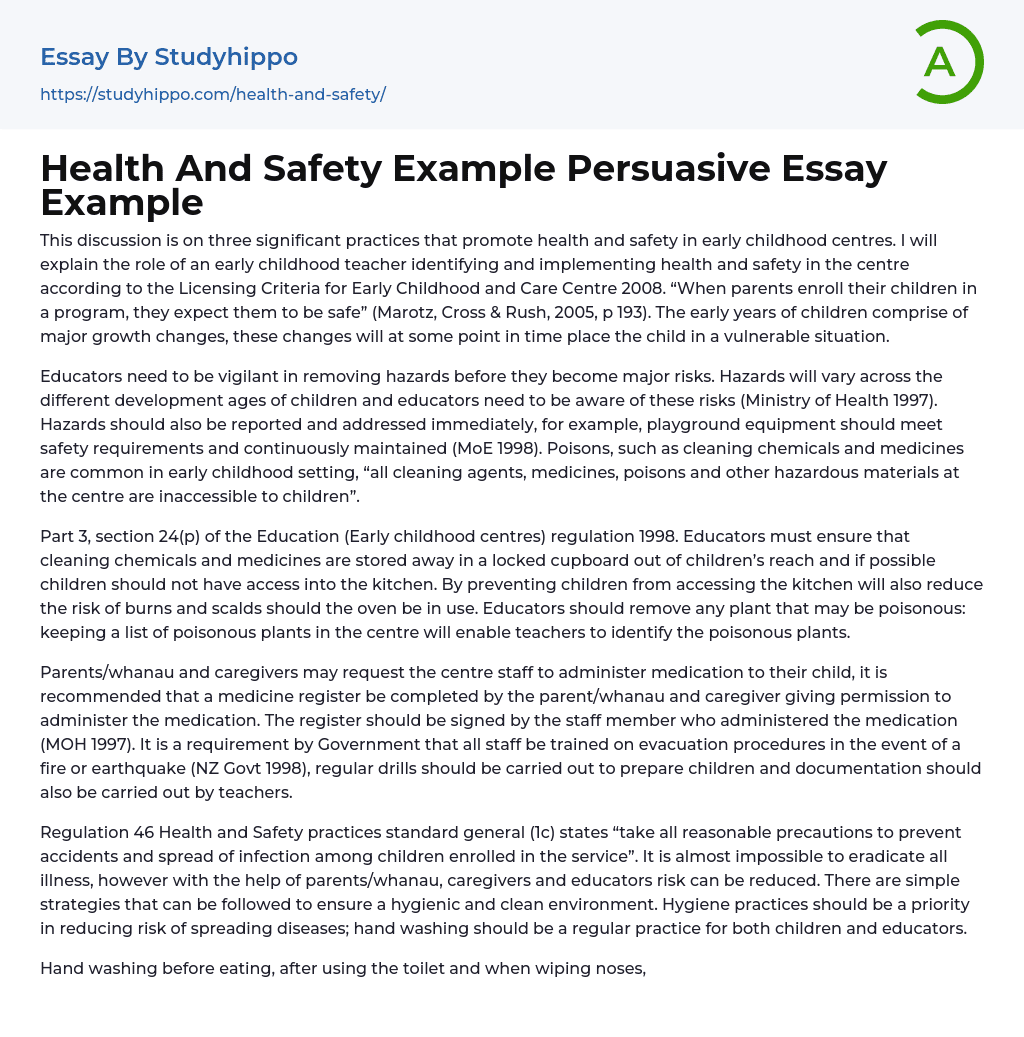In this paragraph, the significance of three practices that promote health and safety in early childhood centers is emphasized. It explains the responsibility of an early childhood teacher in recognizing and implementing health and safety measures, as outlined in the Licensing Criteria for Early Childhood and Care Center 2008. It also highlights the expectation of parents that their children will be safe when they enroll them in a program, as stated by Marotz, Cross & Rush (2005, p 193). Furthermore, it acknowledges that young children undergo significant growth changes during their early years, which can make them vulnerable at times.
Educators must exercise caution and address potential dangers to prevent them from becoming serious threats. The risks that children face vary depending on their developmental stages, so educators should be aware of these
...hazards (Ministry of Health 1997). It is also crucial to promptly report and handle hazards. For example, playground equipment must adhere to safety standards and undergo regular maintenance (MoE 1998). Early childhood settings often have various poisonous substances such as cleaning agents and medications. Therefore, it is imperative that "all cleaning agents, medicines, poisons, and other hazardous materials at the center are kept out of reach for children."
According to Part 3, section 24(p) of the Education (Early childhood centres) regulation 1998, educators have a responsibility to store cleaning chemicals and medicines in a locked cupboard out of children's reach. It is also advisable to prevent children from accessing the kitchen to minimize the risk of burns and scalds if the oven is in use. Additionally, educators should remove any potentially poisonous plants and keep a list of
these plants in the center for identification purposes.
Parents/whanau and caregivers have the option to request the centre staff to give medication to their child. To ensure proper authorization, it is advised that a medicine register is completed by the parent/whanau and caregiver, granting permission for the administration of medication. The register should also be signed by the staff member responsible for administering the medication (MOH 1997). According to Government regulations (NZ Govt 1998), all staff must receive training on evacuation procedures in case of a fire or earthquake. It is recommended that regular drills are conducted to prepare children, and teachers should also document these drills.
Regulation 46 Health and Safety practices standard general (1c) emphasizes the importance of taking necessary precautions to prevent accidents and the spread of infection among children enrolled in the service. While it is difficult to eliminate all illnesses completely, collaboration between parents/whanau, caregivers, and educators can help mitigate risks. By implementing simple strategies, a hygienic and clean environment can be achieved. Emphasizing the importance of hygiene practices is vital in minimizing the risk of disease transmission. Regular hand washing should be practiced by both children and educators alike.
Hand washing before eating, after using the toilet and when wiping noses, changing nappies and before handling food. Teachers should wear disposable gloves during nappy changes and immediately dispose of soiled nappies in a container with a tight fitting lid. In conclusion, this text has discussed the importance of an early childhood teacher promoting and implementing health and safety practices in the center according to the Licensing Criteria for Early Childhood and Care Center.
- Anatomy and Physiology essays
- Addiction essays
- Biodegradation essays
- Dental Care essays
- Disease essays
- Disorders essays
- Health Care essays
- Intelligence Quotient essays
- Nutrition essays
- Olfaction essays
- Public Health essays
- Women's Health essays
- World health organization essays
- Cancer essays
- Infectious Disease essays
- Lung Cancer essays
- Neurology essays
- Physical Exercise essays
- Medicine essays
- Sex essays
- Inquiry essays
- Disability essays
- Poison essays
- Action Potential essays
- Nervous System essays
- Childbirth essays
- Puberty essays
- Blood essays
- Kidney essays
- Neuron essays
- Body essays
- Glucose essays
- Sense essays
- Heart essays
- Skeleton essays
- Human Physiology essays
- Eye essays
- Immune System essays
- Muscle essays
- Skin essays
- Brain essays
- Central Nervous System essays
- Human Skin Color essays
- Digestive System essays
- Common sense essays
- Respiration essays
- alcoholism essays
- Smoking essays
- Casino essays
- Tobacco essays




